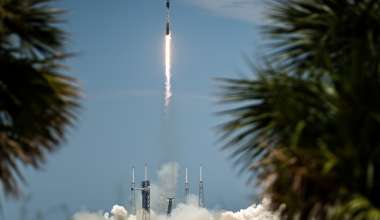In a rapidly evolving threat environment, maintaining space superiority demands delivering cutting-edge technology with speed, flexibility and seamless coordination. As threats accelerate and mission needs shift in real time, The Aerospace Corporation has made investments in increasing agility in launch manifesting and toward a new approach to modular satellite integration to enable launch resiliency, speed and responsiveness commensurate with mission risk. Timelines once measured in months and years are now being accelerated into weeks or even hours.
Agile launch manifesting enables mission planners to identify, prioritize and integrate payloads quickly and across various providers and platforms.
“Agile launch manifesting is redefining how national security space responds to emerging threats,” said Matt Kanter, systems director for the Small Launch Group at Aerospace. “The ability to move from decision to execution in days, not years, is quickly becoming a requirement.”
How Aerospace Is Enabling Agility with Confidence
Aerospace plays a central role in advancing agile launch manifesting by delivering systems integration, independent analysis and deep technical expertise. From pre-screening payload compatibility to establishing manifest frameworks for tactically responsive space, Aerospace connects government requirements with launch readiness.
Agility depends on removing long-standing friction points that slow down launch preparation. Common delay drivers such as mission-unique interfaces and launch site processing conflicts are mitigated through early-phase coordination, technical standardization and development of new tools and technologies.
A major Aerospace advancement in standardization is the Slingshot platform, an experimental testbed 12-unit CubeSat that utilizes a standard interface to enable a broad range of technologies to plug together with greater flexibility and adaptability. The success of the Slingshot 1 mission, which launched in 2022, demonstrated the potential for modular technologies and rapid prototyping to improve the flexibility of satellites and expedite the integration timeline for payloads.
Aerospace is also leading an effort to define highly standardized interfaces between payloads and launch vehicles to enable a dramatic reduction in the duration and complexity of the launch mission integration process. An industry committee is developing a standard that defines interfaces in much greater detail and specificity than existing interface standards.
“With these highly standardized interfaces, we are targeting a 50 percent reduction in design integration time on NSSL-class missions,” said Doug Conley, chief engineer of Launch, Missiles and Mobility and committee chair.
Complementing these interface standardization advancements is Aerospace’s Multiconfiguration Loads Analysis (MLA), a process that uses parametric analysis to streamline structural compatibility assessments across multiple payload and launch vehicle combinations, particularly for rideshare manifests.
“With MLA, the launch vehicle and payload communities keep their options open until just a few months before launch, rather than having to decide a year or more in advance what will go into orbit on a particular launch,” said Erik Mellquist, systems director for Mission Integration at Aerospace, and part of the team that led development of the MLA process. “MLA addresses one of the most persistent contributors to launch delays by resolving late-stage structural compatibility issues and is making rapid manifesting a reality.” MLA is now a requirement for the National Security Space Launch program and is being implemented across the launch provider community. Together, these efforts—and Aerospace’s close collaboration with government and commercial partners—are making agile launch manifesting a scalable, repeatable reality.
An Evolving Model of Readiness
Agile launch manifesting reflects a broad change in how space missions are conceived, validated and delivered. Resilience is now measured not just in redundancy, but by the speed and adaptability of the entire space enterprise. By shifting from fixed schedules to adaptable frameworks, mission teams can align payloads to evolving needs.
With deep experience in mission assurance, launch systems, digital transformation and space architectures, Aerospace remains a critical enabler of this transition.
“Readiness is no longer marked by calendar milestones but by the ability to adapt confidently in moments that matter,” Mellquist said. “Agile launch manifesting ensures those moments are met with precision, speed and trust. This is a new standard for national security space, and Aerospace is on the forefront of defining how the enterprise gets there.”





